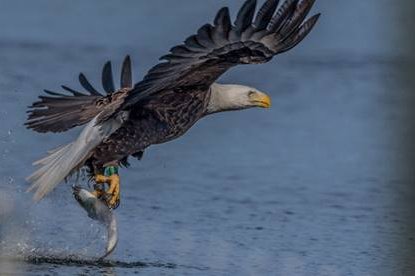
June 03, 2024
 Provided Image/NJDEP
Provided Image/NJDEP
A bald eagle is shown above in New Jersey. The state Department of Environmental Protection has proposed removing bald eagles and ospreys from its list of endangered species because populations of both birds have dramatically recovered in recent decades.
After decades of efforts to restore populations of bald eagles and ospreys, New Jersey wildlife officials are proposing to take both birds of prey off the state's endangered species list.
Once critically threatened in large parts of the United States, populations of both species have recovered significantly thanks to conservation programs. In the 1970s and early 1980s, New Jersey had just one surviving pair of bald eagles. The state now has documented a record 267 nesting pairs, including 255 that laid eggs.
Ospreys, also known as fish hawks, live mainly along New Jersey's coast and get their food from the state's creeks, marshes and bays. Last year, state wildlife experts documented a record 800 occupied osprey nests, up from a low of about 50 in the early 1970s.
Both species were decimated by habitat loss and the use of pesticides like DDT, which polluted waterways and food sources during and after World War II. Reproductive problems caused by DDT led to bald eagles and ospreys laying eggs that had shells too thin to withstand incubation. The insecticide used to control mosquitos was federally banned in 1972.
In the early 1980s, New Jersey began a bald eagle reintroduction program that involved relocating pairs from Canada and fostering them in habitats where they had once been abundant. Populations saw major gains over the last 15 years, particularly in areas around the Delaware Bay. Nesting pairs have more than doubled since reaching 119 in 2012.
“The recovery of these species from near extirpation during the 1980s in New Jersey is a dramatic example of what is possible when regulations, science, and public commitment come together for a common purpose,” said David Golden, assistant commissioner of the New Jersey Department of Environmental Protection's Fish & Wildlife division.
New Jersey currently lists bald eagles as endangered in the state during their breeding season and threatened during the non-breeding season. Ospreys are currently listed as threatened in New Jersey. Under the proposed rule change, bald eagles' status would be changed to a species of special concern. Ospreys would be classified as stable.
NJDEP will accept public comments on the proposed rule change until Aug. 2.
Bald eagles were removed from the federal list of endangered species in 2007, but they remain federally protected from hunters under the Bald and Golden Eagle Protection Act and the Migratory Bird Treaty Act. In Pennsylvania, which has had success with similar restoration efforts, bald eagles were removed from the state's endangered and threatened species lists in 2014.
Increased populations of both species have contributed to more frequent sightings in the region, including encounters with injured birds. In Ocean City, a bald eagle that appeared to be stunned was rescued on a residential block in March and taken to a Delaware wildlife refuge to be rehabilitated. And in February outside Harrisburg, a Pennsylvania state trooper rescued a bald eagle that had been injured after it was struck by a car.
On the Atlantic City Expressway, the Golden Nugget casino opted to keep an outdated billboard advertisement up two summers ago when it was discovered a family of ospreys had made a home on the structure.
“Many people have worked for years and decades to bring these species back from the brink, including biologists, volunteers, and all those who protect and steward habitat for rare wildlife," said Kathy Clark, chief of the state's endangered and nongame species program. "This is an achievement for all those who work on behalf of the natural ecosystems of New Jersey.”